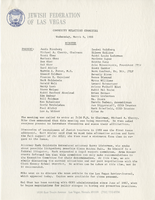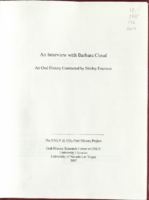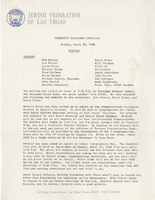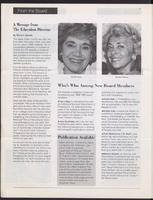Search the Special Collections and Archives Portal
Search Results

Photograph of Library at Desert Torah Academy, Las Vegas (Nev.), September 22, 2016
Date
Archival Collection
Description
The Multimedia Library inside the Desert Torah Academy on the Robert Cohen Educational Campus at 1312 Vista Drive.
Image

Transcript of interview with Frankie Perez by Elsa Lopez and Laurents Bañuelos-Benitez, November 5, 2018
Date
Archival Collection
Description
Frankie Perez (1986- ) is an individual that constantly found himself navigating two worlds, whether it was military versus civilian; female versus male; or being Latinx in the United States. As a result of this navigation, Perez has a unique perspective on our ever more complicated world that not many individuals possess. Perez served in the military during the Do Not Ask, Do Not Tell policy which made it difficult for someone dealing with gender identity, to seek out the proper support they need. Despite the policy, and other policies that were put in place afterwards to inhibit the transgender community in the military, Perez began his transition while still serving his country. In direct contradiction of popular opinion, Perez discovered that the military easily accommodated his transition. Outside of the military Perez is an active voice in the LGBTQ community. As a member of the LGBTQ, Latinx, and military community, Perez has a unique perspective that he uses to fight for both LGBTQ and Latinx rights. Currently, Perez is finishing his degree in gender and sexuality studies at UNLV. He hopes to use his education to help people have the difficult discussions and improve conditions for his communities.
Text

Photograph of Clark County High School students and staff, Las Vegas, 1912
Date
Archival Collection
Description
Image
R. Guild Gray oral history interview
Identifier
Abstract
Oral history interview with R. Guild Gray conducted by James Benson on March 05, 1977 for the Ralph Roske Oral History Project on Early Las Vegas. Guild discusses Nevada’s school districts’ history, his teaching background, and the Peabody Study Abroad institute.
Archival Collection

Jewish Federation correspondence, meeting minutes, and other records, item 14
Description
Community Relations Committee meeting minutes for the Jewish Federation of Las Vegas, Nevada, March 9, 1988.

Transcript of interview with Barbara Cloud by Shirley Emerson, May 30, 2006
Date
Archival Collection
Description
Text

Jewish Federation correspondence, meeting minutes, and other records, item 17
Description
Community Relations Committee meeting mintues for the Jewish Federation of Las Vegas, Nevada, March 28, 1988.
Sperling Kronberg Mack Holocaust Resource Center Records
Identifier
Abstract
The Sperling Kronberg Mack Holocaust Resource Center Records (1971-2018) mainly consists of correspondence, event planning documents, financial records, subject files, and newspaper clippings created by or related to the Sperling Kronberg Mack Holocaust Resource Center and the Nevada Governor’s Advisory Council on Education Relating to the Holocaust. Materials document educational conferences, remembrance events, and student field trips; curriculum planning, involvement with the Clark County School District, and educational materials about the Holocaust and other related historical events; and grant and fundraising activities. The collection also includes photographs and proclamations.
Archival Collection
Keith Whitfield (University of Nevada, Las Vegas) oral history interview conducted by Kelliann Beavers and Taylor Cummings: transcript
Date
Archival Collection
Description
From the Lincy Institute "Perspectives from the COVID-19 Pandemic" Oral History Project (MS-01178) -- Education sector interviews file.
Text

